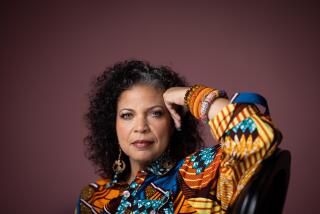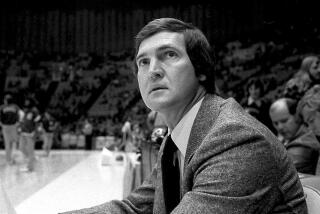Ex-Laker Girl Slam-Dunks : Paula Abdul scores with new singing career and debut album
Singer Paula Abdul chuckled at the thought of being married to L.A. Lakersâ center Kareem Abdul-Jabbar.
Thinking of how theyâd look together--at 5-foot-2 sheâs about two feet shorter--struck her so funny that the chuckle mushroomed into roaring laughter. Abdul, who currently has the No. 1 pop single with âStraight Up,â was doubled up in her chair at a West Hollywood restaurant during a recent interview.
âI wouldnât have to do much to change my name if we were married,â said Abdul, a perky, bubbly type whose little-girl voice makes her sound much younger than her 25 years. âIâd just tack on Jabbar to my name. Because of my name, people used to ask me if we were married all the time.â
Those people made the connection because of her link to the Lakers. Until a few years ago, Abdul was head of the Laker Girls, the teamâs cheerleading squad. Choreographing their routines was her entree into the music business.
She was best known as a rock-video choreographer until âStraight Up,â the third single from her debut album, âForever Your Girl,â established her as one of the best of the flock of pretty dance-music queens.
A former cheerleader at Van Nuys High School, Abdul beat out hundreds of competitors in 1980 for a coveted spot with the Laker Girls. A year later she was the leader, choreographing the routines. She de-emphasized conventional cheers and emphasized dancing.
âI joined the Laker girls for fun,â said Abdul, who was with the squad for six years. âBut those games arenât just games. Thereâs a heavy show-biz scene there too. Thereâs a lot of people in the entertainment business in the stands.â
A budding choreographer couldnât have asked for a better showcase. The dance routines were more than just entertainment. They were advertisements for Abdulâs choreographic skills. âThere were all sorts of calls to the Forum office with job offers--TV commercials, TV shows,â she said.
For a while, though, Abdul, a student at Cal State Northridge in the early â80s, had another goal. âI wanted to be a sports commentator,â she recalled. âI used to sit in the booth with (Lakers announcer) Chick Hearn and watch how he did things. Heâd even interview me at half time.â
But a big choreography break steered her permanently in that direction. In 1984, when the Jacksons were at the Forum to see the Lakers, they were checking out more than the game.
âI got this notice that they wanted to talk to me,â said Abdul. âThey wanted me to fly to New York to choreograph a video. I was floored. I had never done anything like a video before.â
Abdul choreographed routines for the video of âTorture,â a song on the Jacksonsâ âVictoryâ album. âMy only problem was how to tell the Jacksons how to dance,â she said. âImagine me telling them what routines to do. I was young, I was scared. Iâm not quite sure how I got through that.â
A year later, her exposure with the Laker Girls got her another assignment, coincidentally with another Jackson--Janet. âAn executive with A&M; Records who had season tickets liked what I did with the Laker Girls and wanted me to work with Janet on her dancing and her videos,â Abdul said.
Abdul not only helped turn Jackson into a polished dancer but also choreographed the videos for the âControlâ album. Those videos did as much for Abdul as they did for Jackson.
The flood of choreography assignments included videos--for ZZ Top, Duran Duran and the Pointer Sisters-- and movies such as âThe Running Manâ and âComing to America.â In 1986, she was so busy she had to drop out of the Laker Girls. By then another activity was taking more and more time--singing.
Though Abdul was dancing at age 7, she started singing in her teens, working with a theatrical-musical group during summer vacations. By her late teens, she was more into dancing--contemporary and theatrical. Despite years of ballet training, she had given up on ballet as a career, figuring she was too short.
But while she was expanding her dancing skills and learning the rudiments of choreography, she never really discarded the notion that she might also be a singer.
âIâd always admired Liza Minnelli,â Abdul said. âShe can dance and sing. I wanted to be one of those Broadway-type performers who could do it all.â
Abdul canât do it all quite yet. Her singing still needs some polish. âForever Your Girlâ is a typical dance-music album, emphasizing instrumentals and rhythms while beefing up the singerâs voice with studio techniques. It was mostly the strong hooks that lured listeneres to âStraight Upâ-- one of last yearâs best pop singles--not her vocals, which are just passable.
Abdul has no illusions about being a great vocalist just yet. âIâm not a really soulful singer--not as soulful as I want to be,â she said. âWith my singing, thereâs room for improvement.â
Janet Jackson was important to Abdulâs singing career in several ways. First of all, Abdul, who had been shopping her demonstration tapes to record companies for several years, got moral support and encouragement from Jackson. But most important, Jacksonâs âControlâ album was such a smash that every label was in the market for a female R&B;/dance-music singer like her. In 1987, Virgin Records signed Abdul as their entry in this category.
That signing took a while to pay off. Released last June, the âForever Your Girlâ album seemed to be going nowhere at first despite a black-chart hit, âKnocked Out,â written by the hot team of L.A. and Babyface. But late last year, pop stations turned on to âStraight Up,â which went straight up the chart, pulling the album--now No. 13 on the Billboard pop chart--with it.
âWhat am I?â mused Abdul. âPeople ask me that all the time. Iâm a Valley Girl--born and raised in the Valley. But Iâm not what people think I am.â
With her olive-colored skin, she could be just about anything--black, white, Mexican, Arabic. âIâve been called everything,â said Abdul, whose father is Syrian and Brazilian and whose mother--a classical pianist--is French-Canadian.
What is she most often called?
âMaybe black, because of the music,â she replied. âI sing R&B; music--dance music--thatâs aimed at the black audience. They think Iâm one of them. People tell me all the time: âIâm glad to see another sister (black woman) making it.â â
There was a time, though, when she was a student at Van Nuys Junior High School, that her heritage worked against her. âThen blacks and Mexicans gangs were fighting each other,â she recalled. âBlacks thought I was Mexican and the Mexicans thought I was black. I was caught in the middle. I was getting it from both sides. It was scary sometimes.â
But most often, she concluded, having an unclear identity is a bonus: âI can be what I want. I can fit into any situation. People are always curious about someone like me. Itâs fun to be a mystery.â
More to Read
The biggest entertainment stories
Get our big stories about Hollywood, film, television, music, arts, culture and more right in your inbox as soon as they publish.
You may occasionally receive promotional content from the Los Angeles Times.










